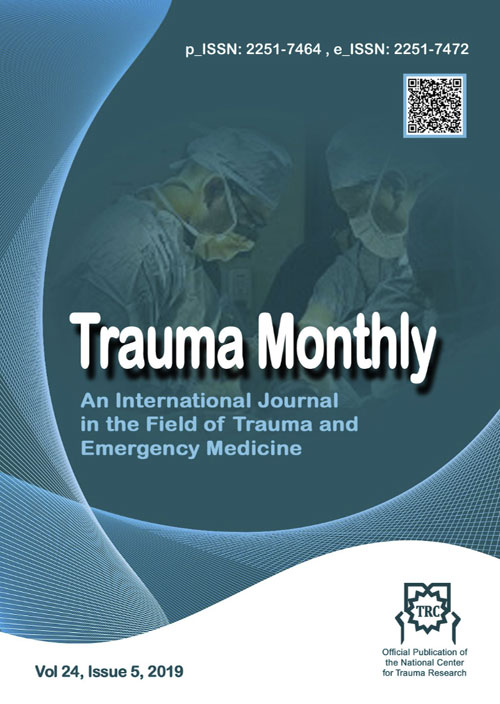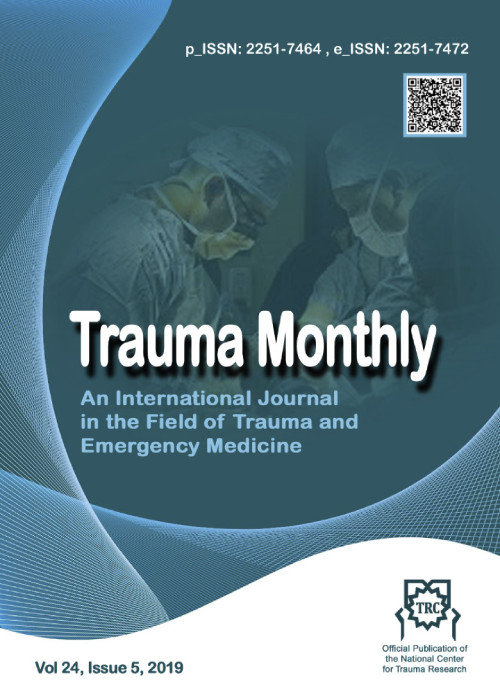فهرست مطالب

Trauma Monthly
Volume:26 Issue: 4, Jul--Aug- 2021
- تاریخ انتشار: 1400/05/14
- تعداد عناوین: 8
-
-
Pages 185-186
-
Pages 187-193BackgroundTibial and femoral nonunion is not unusual after intramedullary fixation and might lead to multiple surgical procedures and long-term disabilities. Different surgical techniques have been described for management of lower limb long bone nonunion primarily treated with intramedullary nailing. Despite the use of various procedures, the success rate of most of them are suboptimal, increases the risk of related complications and costs.ObjectivesAugmented plating concomitant with autologous bone grafting technique make it possible to improve healing in a single operation.MethodsIn this study, 19 patients with lower limb long bone nonunion were primarily fixed with intramedullary nails, were treated with augmented plating and autologous bone grafting and followed for one year.ResultsThe union rate was 94.7% with a mean union time of 4.75 months, 18 patients healed completely with solid union and only one case of femoral shaft nonunion remained. Infection and other surgical-related complications were not detected. After one year follow up, Visual Analog Scale was 31 ± 18.8, and decrement in active knee range of motion was more than 20% compared with opposite side in 47.4% of the patients.ConclusionAccording to the results, the single stage augmented plating with locking plates combined with autologous bone grafting can be used as a useful method in treatment of femoral or tibial nonunion.Keywords: Fractures, ununited, Bone Plates, Intramedullary Nailing, Bone Grafting
-
Pages 194-198BackgroundTraumatic peripheral nerve injuries (PNIs) caused by penetrating and lacerated trauma are among the most prevalent microsurgical injuries. Post-treatment follow-up and prognosis of patients undergoing repair are often based on clinical examinations and electrodiagnostic findings. Therefore, a reliable, inexpensive, useful, and rapidly accessible diagnostic method is necessary during the patient's follow-up.ObjectivesThis study aimed to assess the relationship between ultrasound imaging and treatment outcomes in patients with median peripheral nerve injury.MethodsIn this cohort study, 21 eligible patients with symptoms of acute median nerve injury (MNI) caused by penetrating trauma in microsurgery were studied from June 2018 to June 2019. The patients underwent ultrasonography three months after repair and were followed up for at least nine months. The outcomes of the treatment were compared with those obtained six months after ultrasonography.ResultsIn all studied patients, mean thicknesses of the repaired nerve on the distal and the proximal sides were 2.58±0.51 and 2.51±0.61 mm2, respectively; 12 cases (57.1%) recovered very well nine months after surgery and in nine cases (42.9%) no nerve recovery was observed based on clinical electromyography (EMG) examinations and nerve conduction velocity (NCV). The amount of neuroma formed at the repair site was lower in well-recovered patients (1.5±0.4 mm3) than those with no recovery (4.9±1.5 mm3). No re-rupture was observed at the repair site. Each group underwent two-four repairs of flexor tendons.ConclusionUltrasound can be used as an effective and non-invasive method for assessment of PNI and follow-up of reconstructive surgery.Keywords: Outcomes Assessment of Median Nerve Repaired by Ultrasonography
-
Pages 199-205BackgroundTraffic accidents are among the main causes of death and disability in the world.ObjectivesThis study aimed to determine the predictors of mortality in patients injured due to traffic accidents, in southern Iran.MethodsThis cross-sectional study was conducted on 1793 road accident patients referred to Imam Hassan Trauma Hospital. Data were retrospectively collected from medical records over a period of 12 months from March 2018 to February 2019. The data were analyzed using STATA software (version 16.0).ResultsA total 1745 patients (97.4%) survived and 47 (2.6%) patients died. The average age of those who survived and those who died were 27.2±0.4 and 25.6± 2.2 years, respectively (p value=0.7). There was no significant relationship between gender and hospital mortality (p=0.19). According to the results, 38.8% of cases died from motorcycle accidents (p value=0.003). Suburban road accidents 2.6 (95%CI: 1.4, 4.8), Alcohol use 2.4 (95%CI:1.3, 4.3), pedestrian injuries 3.2 (95%CI:1.5, 6.8), head and neck injury 45.8 (6.3, 333.1) as well as thoracic injuries 22.6 (95%CI:6.9, 72.9), Abdominal injuries 6.2 (95%CI 3.2, 11.9), Vertebral injuries 9.3 (95%CI: 4.3, 19.9), extremity injuries 4.3 (95%CI:1.9, 9.7), abnormal of creatinine 4.1 (95%CI: 1.01, 16.4) respectively. ISS 20.32(95%CI: 4.85, 96.26), and GCS 1871.5 (95%CI: 250.6, 13975.8), were associated with hospital mortality in road accident patients. The Multivariate analysis shows that ISS≥16 and GCS score≤8, could predict the probability of death in road accident patients.ConclusionIn summary, suburban roads, alcohol use, ISS≥16, GCS≤8, head and neck injury, thoracic injury, abdominal injury, vertebral injury, extremity injury and abnormal creatinine were independently associated with hospital mortality in injured patients.Keywords: Hospital mortality, Injury severity score, Accidents, Iran
-
Pages 206-212BackgroundLow back pain (LBP) management via conservative therapy with intervention fails in some cases. However, there are still many challenges to choose the best choice. Minimally-invasive techniques such as ozone therapy are emerging choices for surgery.ObjectiveWe evaluated the effects of ozone therapy on patients with LBP with protruding disc herniation who failed to respond to medical treatment.MethodsIn this Randomized phase III clinical trial (2017-19), one hundred patients admitted to Imam Reza Hospital (Tabriz-Iran) for herniated disk-induced LBP were randomly divided (shape- and color-identical envelopes) into two case and control groups. Patients in the case group were treated with ozone therapy (25 mcg/mL in 5 cc volume) plus medical therapy (naproxen 500 mg and baclofen 10 mg, both two times a day). Alternatively, patients in the control group received only conventional medical therapy. Primary outcomes such as changes in pain intensity (VAS) and basal test before and after treatment and also secondary outcomes like the amount of analgesic used were evaluated in the patients during two weeks, three months and six months after surgery. Student T-test and Chi-square were compared for comparing the data.ResultsMean pain intensities estimated by VAS and improvement of restless leg syndrome were not significantly different between the two groups during two weeks (p =0.8), three months (p =0.5) and six months (p =0.9) after the intervention. Pain intensity was found to be lower in both groups after the intervention compared with before treatment (p =0.001 for both). Moreover, significant differences were found between two groups in the Lasegue test during two weeks (p =0.02) and six months (p =0.01) after the intervention.ConclusionApplication of ozone therapy not only improves clinical pain syndrome in LBP patients but also leads to improved medical treatment in these patients.Keywords: Low back pain, Herniated disk, Ozone therapy, Medical therapy
-
Pages 213-221BackgroundOpen fractures are a difficult entity, often complicated by infection and nonunion. Bone loss in such fractures adds to the complexity. Conventional techniques of bone defect management are mainly directed toward fracture union but not against preventing infection or joint stiffness.ObjectivesIn this study, we evaluated Masquelet's technique for the management of open distal end Femur fractures with bone loss.MethodsTwenty-two patients with open distal end fractures with bone defects who presented within 3 days of trauma from January 2015 to December 2018, treated by the Masquelet's technique are included in this study. All the patients were operated on by the same surgeon. All the patients were taken up for the first stage of surgery immediately after the presentation. Details of the type of injury, location, soft-tissue condition, length of bone defect, type of fixation, the time difference between antibiotic cement spacer placement and bone grafting, and time to the union were documented.ResultsFractures with Type IV bone loss (segmental loss) united slower than fractures having some cortical continuity (Type II and III), P=0.003. In Type IV, the bone loss average time to union was 316.6±44.5 days, whereas, in Type III and II, it was 240±30 and 180, respectively. In the first stage, internal fixation with antibiotics cement spacer was done in all cases. In patients with internal fixation with 2nd stage spacer removal plus bone grafting done, time to union was 244.1±42.9 days. No patients had an infection after the first stage of surgery.ConclusionThe technique of delayed bone grafting after the initial placement of a cement spacer provides a reasonable alternative for the challenging problem of significant bone loss in extremity reconstruction. This technique can be used in either an acute or delayed fashion with equally promising results. The bioactivity of the membrane created by filling large bony defects with cement leads to a favorable environment for bone formation and osseous consolidation of a large void. As this technique becomes more widely applied, the answer to which graft substances to place in the void may become clearer. Increasing clinical evidence will also help support the use of this technique in treating segmental bone loss.Keywords: Induce membrane, Distal Femur, Antibiotic cement spacer, Bone Graft
-
Pages 222-227BackgroundIn the elderly, proximal humerus fractures are not unusual. The treatment of these injuries are often complicated.ObjectivesThis study aimed to evaluate the effect of deltoid tuberosity index on the outcome of proximal humeral fractures treated with a locking plate.MethodsOne hundred consecutive patients with displaced fractures of the proximal humerus had open-reduction and internal fixation using a locking plate. The patients were divided into two main groups (low density group) DTI<1.4 and DTI>1.4 (normal density group) and at the end of the study, treatment and failure were assessed in the two groups.ResultsIn this study, 100 patients with proximal humeral fracture who were candidates for locking plating surgery were evaluated. The mean of DTI in all patients was 1.48 with a minimum of 1.10 and a maximum of 2.20. Based on the Pearson correlation coefficient, with increasing age, the constant score decreased in the studied patients, which was statistically significant (r=-0.216, p-value = 0.031). Also, in patients with DTI less than 1.4 and more than 1.4, the Constant score was 73.02 and 77.88, respectively. This difference was not statistically significant (p-value=0.054). There was a statistically significant relationship between Constant Score, DTI and patients' gender (p-value≤0.05). While there was no statistically significant relationship between fracture type and constant score. Pearson correlation coefficient between DTI and age of patients was -0.30, which decreased with increasing age of patients. This was statistically significant (r=-0.30, p-value=0.003).ConclusionThe results of this study show that the deltoid tuberosity index can be effective on proximal humoral fracture surgery treated with locking plating.Keywords: Deltoid Tuberosity Index, Proximal Humerus Fractures, constant score
-
Pages 228-234BackgroundMany studies have investigated the effects of Kinesio tape on the symptoms of carpal tunnel syndrome (CTS).ObjectivesThe present study aimed to review the results of clinical trials on the use of Kinesio tape to improve CTS symptoms.MethodsThe present systematic review was based on PRISMA guidelines (Preferred Reporting Items for Systematic Reviews and Meta-Analyses) on clinical trials. The keywords “Carpal Tunnel Syndrome, Median Nerve, Kinesio Tape, and Physical Therapy” were searched in Embase, PubMed, SID, Magiran, Cochrane Library, Scopus, ScienceDirect, Springer, Ovid, ProQuest, PEDro, and Google Scholar databases.ResultsOut of 1259 articles, only 13 met the requirement for inclusion in the study. The results of 11 articles indicated that the use of Kinesio tape could significantly reduce CTS symptoms.ConclusionThe use of Kinesio tape reduces CTS symptoms (ie, pain, numbness, and hand function).Keywords: carpal tunnel syndrome, Kinesio Tape, Pain, Symptoms


